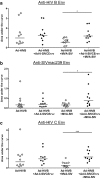Virus-like vaccines against HIV/SIV synergize with a subdominant antigen T cell vaccine
- PMID: 31126293
- PMCID: PMC6534914
- DOI: 10.1186/s12967-019-1924-1
Virus-like vaccines against HIV/SIV synergize with a subdominant antigen T cell vaccine
Abstract
Background: In non-human primates (NHPs) and humans, partial protection from HIV/SIV infection or suppression of replication is achievable by Env-binding antibodies and Gag-specific CD8+ T-cells targeting protective epitopes. Unfortunately, such T-cell responses are frequently dominated by responses to non-protective, variable epitopes. In this study we attempt to combine three independent approaches, each developed to prevent immunodominance of non-protective epitopes. These approaches were (1) vaccines consisting exclusively of putatively protective p24 Gag highly conserved elements (CEs), (2) vaccines using solely subdominant antigens which were acutely protective in a recent NHP trial, and (3) virus-encoded virus-like particle vaccines (virus-like vaccines/VLVs) using heterologous Env and Gag sequences to enable selection of broadly cross-reactive responses and to avoid immunodominance of non-conserved sequences in prime-boost regimens as previously observed.
Methods: We vaccinated outbred CD1 mice with HIV-1 clade B Gag/Env encoded in an adenoviral prime and SIVmac239 Gag/Env in an MVA boost. We combined this completely heterologous immunization regimen and the homologous SIVmac239 Gag/Env immunization regimen with an additional prime encoding SIV CEs and accessory antigens Rev, Vif and Vpr (Ad-Ii-SIVCErvv). T-cell responses were analyzed by intracellular cytokine staining of splenocytes and antibody responses by trimer-specific ELISA, avidity and isotype-specific ELISA.
Results: Env dominance could be avoided successfully in the completely heterologous prime-boost regimen, but Env immunodominance reappeared when Ad-Ii-SIVCErvv was added to the prime. This regimen did however still induce more cross-reactive Gag-specific CD8+ T-cells and Env-specific antibodies. Including Ad-Ii-SIVCErvv in the homologous prime-boost not only elicited accessory antigen-specific CD8+ memory T-cells, but also significantly increased the ratio of Gag- to Env-specific CD8+ T-cells. The CD4+ T-cell response shifted away from structural antigens previously associated with infection-enhancement.
Conclusion: The homologous Gag/Env prime-boost with Ad-Ii-SIVCErvv prime combined acutely protective CD8+ T-cell responses to subdominant antigens and Env-binding antibodies with chronically protective Gag-specific CD8+ T-cells in outbred mice. This vaccine regimen should be tested in an NHP efficacy trial.
Keywords: Adenoviral vectors; Antibodies; Heterologous viral vectored prime-boost immunization; Human immunodeficiency virus; Subdominant antigen vaccine; T-cells; Virus-like particles; Virus-like vaccines.
Conflict of interest statement
PJH is an inventor on a manuscript-related patent (published as WO2007062656) and a founder and shareholder of InProTher ApS, a biotech company which holds a license to use the invariant chain sequence for vaccination purposes against certain indications including HIV. ACA became an employee of InProTher between submission and acceptance of the manuscript.
MS and LN declare that they have no competing interests.
Figures





Similar articles
-
Increased T cell breadth and antibody response elicited in prime-boost regimen by viral vector encoded homologous SIV Gag/Env in outbred CD1 mice.J Transl Med. 2016 Dec 20;14(1):343. doi: 10.1186/s12967-016-1102-7. J Transl Med. 2016. PMID: 27998269 Free PMC article.
-
Gag and env conserved element CE DNA vaccines elicit broad cytotoxic T cell responses targeting subdominant epitopes of HIV and SIV Able to recognize virus-infected cells in macaques.Hum Vaccin Immunother. 2018;14(9):2163-2177. doi: 10.1080/21645515.2018.1489949. Epub 2018 Jul 12. Hum Vaccin Immunother. 2018. PMID: 29939820 Free PMC article.
-
DNA Prime-Boost Vaccine Regimen To Increase Breadth, Magnitude, and Cytotoxicity of the Cellular Immune Responses to Subdominant Gag Epitopes of Simian Immunodeficiency Virus and HIV.J Immunol. 2016 Nov 15;197(10):3999-4013. doi: 10.4049/jimmunol.1600697. Epub 2016 Oct 12. J Immunol. 2016. PMID: 27733554 Free PMC article.
-
HIV vaccine research and discovery in the nonhuman primates model: a unified theory in acquisition prevention and control of SIV infection.Curr Opin HIV AIDS. 2013 Jul;8(4):288-94. doi: 10.1097/COH.0b013e328361cfe8. Curr Opin HIV AIDS. 2013. PMID: 23666390 Free PMC article. Review.
-
Is an HIV vaccine possible?Braz J Infect Dis. 2009 Aug;13(4):304-10. doi: 10.1590/s1413-86702009000400013. Braz J Infect Dis. 2009. PMID: 20231996 Free PMC article. Review.
Cited by
-
Cancer Associated Endogenous Retroviruses: Ideal Immune Targets for Adenovirus-Based Immunotherapy.Int J Mol Sci. 2020 Jul 8;21(14):4843. doi: 10.3390/ijms21144843. Int J Mol Sci. 2020. PMID: 32650622 Free PMC article. Review.
-
A longitudinal analysis of immune escapes from HLA-B*13-restricted T-cell responses at early stage of CRF01_AE subtype HIV-1 infection and implications for vaccine design.BMC Immunol. 2022 Apr 2;23(1):15. doi: 10.1186/s12865-022-00491-7. BMC Immunol. 2022. PMID: 35366796 Free PMC article.
-
New Approaches to Dendritic Cell-Based Therapeutic Vaccines Against HIV-1 Infection.Front Immunol. 2022 Jan 4;12:719664. doi: 10.3389/fimmu.2021.719664. eCollection 2021. Front Immunol. 2022. PMID: 35058917 Free PMC article. Review.
References
Publication types
MeSH terms
Substances
LinkOut - more resources
Full Text Sources
Medical
Research Materials

